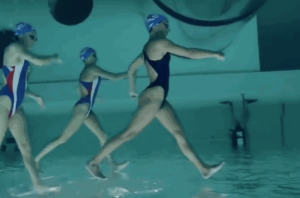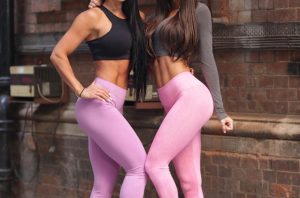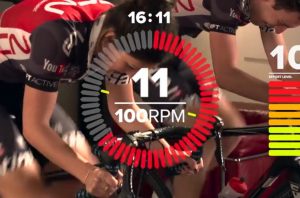The upright row can be used by strength, power, and fitness athletes to build shoulder strength, muscle hypertrophy, and reinforce proper positions and technique in more advanced weightlifting movements.
Step 1. Choose Your Grip Width
Start by determining the grip width you will take, as a wider grip will target more of the posterior shoulders while a narrower grip will emphasize the trapezius more (both grips will target both muscle groups.
Step 2. Stand Tall
Stand the band up to the hip, and pull the chest up tall (assume an erect position).
Step 3. Elbows Up
Pull the elbows upwards and slightly out, keeping the band close to the body.
Benefits
1. Shoulder Size and Muscle
The upright row is a great movement to increase the muscular size and strength of the shoulders, specifically the anterior and lateral heads of the deltoid. This is key for lifters looking to gain size and strength in the deltoids for pressing movements or for general development. When performing this exercise, be sure to use semi-strict to strict form to make sure you are moving the load by elevating the shoulders at the top of the motion rather than using the biceps or forearms to support the movement.
2. Bigger Traps
Building bigger traps is not only needed for stronger deadlifts, squats, and pressing, but it also is a physical feature that many strength, power, and fitness athletes strive for. When performing the upright row, be sure to use a narrow grip if the traps are something you are concerned about, as the wider your hands are the less elevation you can get with the barbell and the more posterior shoulder and shoulder are targeted
3. Better Cleans and Snatches
When looking to increase your ability to clean and snatch, many factors can come into play. For some lifters, issues arise after the first pull (assuming the first pull and set up is ok). After the first pull and the explosion phase in the clean/snatch, the lifter must elevate the traps and elbows to keep the barbell close during the turnover phase (third pull) of the lift. Often, lifters may lack this technical understanding or muscle activation and in turn pull on the barbell with the arms which can cut the terminal height of the barbell down drastically, often resulting in weaker pulls and/or crashing weights.
Muscles Targeted
The upright row is a movement that targets many of the large muscle in the upper back and shoulders, which is key for many movements (see below) in strength, power, and fitness sports. The below muscles are targeted when doing upright rows. Note, that some exercises, such as in Olympic weightlifting, use movements very similar, called high pulls, to target many of the same muscles groups. If this is something you are aware of, the main differentiation of an upright row with a high pull is that the upright row negates momentum from the legs and hips to make the vertical pulling movement target the upper body more.
* Upper Trapezius (narrower grip)
* Posterior Shoulder/Deltoids (wider grip)
* Anterior Shoulder/Deltoids (narrower grip)
* Biceps
* Rhomboids
Who Should Do Upright Rows?
Upright rows are an exercise that nearly everyone can do using a wide variety of grip widths. The key, for any athlete, is to first be able to perform the elevation of the hands in close proximity to the body without any pain of asymmetries prior to loading this movement. While the upright row can help to develop the shoulders and traps (see below), it can irritate the anterior shoulder and/or neck if the lifter is performing the movement incorrectly.
Strength and Power Athletes
Strength and power athletes can benefit from the upright row position due to its ability to increase shoulder strength, muscle mass, and application to weightlifting movements like snatches and cleans.
* Powerlifters: The upright row can be used to increase upper body mass and strengthen the posterior shoulders/traps; both of which can aid in a strong back for movements like deadlifts and low bar squats.
* Strongman Athletes: Strong shoulders, traps, and back muscles aid in nearly every movement in strongman. The upright row is a great accessory exercise to help strengthen smaller muscles in the posterior shoulder and add overall size and strength to the upper back/posterior shoulder.
* Olympic Weightlifters: In addition to increasing strength and hypertrophy of the traps and posterior shoulder, this exercise specially strengthens the muscles and movement patterning needed for successful snatches and cleans.
General and Functional Fitness
The upright row can be used to increase shoulder strength and hypertrophy, for all of the similar reasons discussed above. Note, that some lifters may have issues with the upright row due to the shoulder mobility necessary for the movement (as well a the internal rotation of the shoulder). Due to most beginner lifters often having weak external rotation/poor shoulder mobility, it maybe be best to start with movements like face pulls and reverse flyes if the proper positioning is limited.
Strength – Reps and Sets
Below are recommendations on how to program the upright row for strength and application to other movements (such as high pulls).
* 4-6 sets of 3-8 repetitions
* Less than 1-3 repetitions with heavy loads is generally not advised as it can often lead to breakdowns in form and potential injury (the only exception is with heavy snatch high pulls, done specifically for weightlifting purposes).
Hypertrophy – Reps and Sets
Below are recommendations on how to program the upright row for muscle hypertrophy.
* 3-5 sets of 8-15 repetitions can be used to increase muscular fatigue necessary for muscular hypertrophy.
* Once again, there is a wide array of loading, sets, and rep schemes available to coaches to train the size and strength. The key here is to focus on the muscle contractions and “pump”, rather than just mindlessly moving weights. Additionally, the loads themselves do not need to be heavy to have an effect.
Watch the video above for proper technique.
Click here for our top recommended Unconventional detox plan
Source Bar Bend





